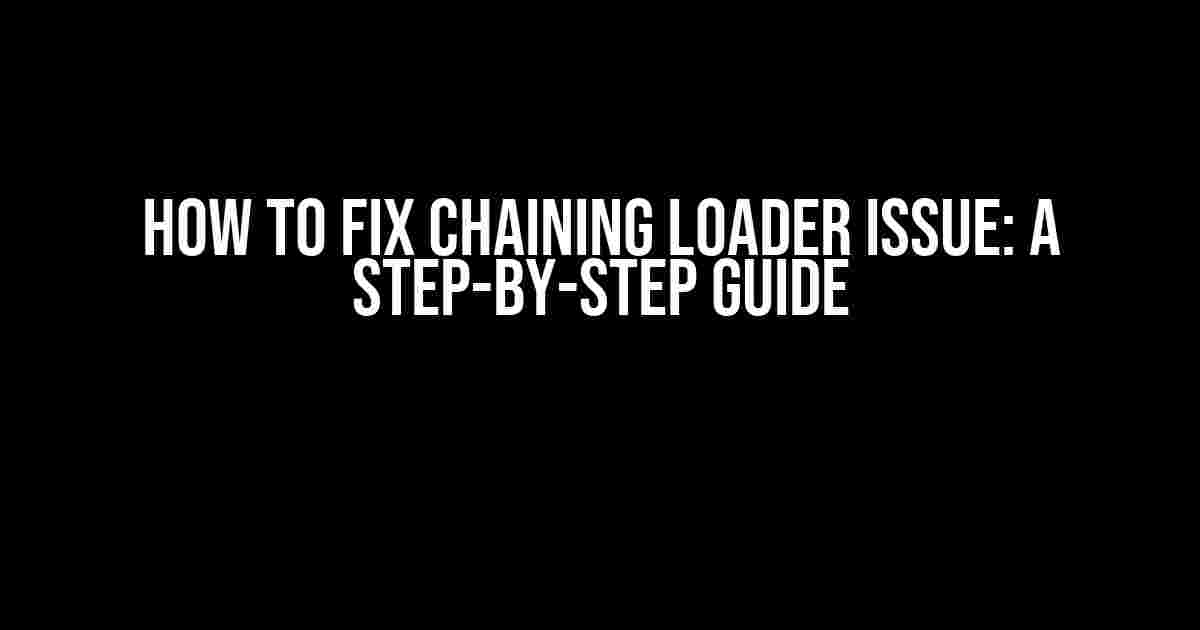Are you tired of dealing with the chaining loader issue in your web application? Do you find yourself stuck in an infinite loop of frustration, wondering why your loader just won’t stop chaining? Fear not, dear developer, for we have got you covered! In this comprehensive guide, we’ll take a deep dive into the world of loaders, exploring the causes, symptoms, and solutions to this pesky problem.
What is the Chaining Loader Issue?
The chaining loader issue occurs when multiple loaders are chained together to load a single resource, resulting in an infinite loop of loader calls. This can lead to a range of problems, including performance issues, slow load times, and even crashes. But don’t worry, it’s not as scary as it sounds – with the right tools and techniques, you can fix this issue in no time!
Symptoms of the Chaining Loader Issue
- Slow or infinite loading times
- Browser crashes or freezes
- Performance issues or lag
- Loader icons that refuse to disappear
Causes of the Chaining Loader Issue
So, what causes this pesky problem? In most cases, it’s due to one of the following reasons:
- Misconfigured Loader Configuration: If your loader configuration is not set up correctly, it can lead to chaining issues.
- Circular Dependencies: When multiple modules or resources depend on each other, it can create a cycle of loader calls.
- Invalid or Missing Resources: If a resource is missing or invalid, the loader may attempt to reload it indefinitely.
- Plugin or Module Conflicts: Conflicts between plugins or modules can cause loaders to chain indefinitely.
How to Fix the Chaining Loader Issue
Now that we’ve covered the causes and symptoms, let’s get down to business – fixing the issue! Here are some step-by-step solutions to help you resolve the chaining loader issue:
Solution 1: Review and Optimize Loader Configuration
Take a closer look at your loader configuration and make sure it’s set up correctly. Check for any typos, incorrect file paths, or misplaced plugins. Here’s an example of a correctly configured loader:
module.exports = {
module: {
rules: [
{
test: /\.css$/,
use: ['style-loader', 'css-loader']
}
]
}
};
Solution 2: Identify and Resolve Circular Dependencies
Use tools like Webpack’s built-in dependency graph or external tools like Dependency Cruiser to identify circular dependencies in your code. Once you’ve found the culprit, refactor your code to break the cycle:
- Rename modules or resources to avoid conflicts.
- Reorganize your code structure to reduce dependencies.
- Use interfaces or abstraction to decouple dependent modules.
Solution 3: Verify Resource Availability and Integrity
Make sure all resources are properly imported and available. Check for any typos, invalid file paths, or missing resources. Use tools like Webpack’s built-in error reporting or external tools like Error Overlay to identify and fix issues:
module.exports = {
module: {
rules: [
{
test: /\.css$/,
use: ['style-loader', 'css-loader']
}
]
},
resolve: {
alias: {
'css-loader': 'path/to/css-loader'
}
}
};
Solution 4: Resolve Plugin or Module Conflicts
Identify conflicting plugins or modules and resolve them by:
- Upgrading or downgrading plugin versions.
- Disabling or removing conflicting plugins.
- Using plugins or modules with compatible versions.
Additional Tips and Tricks
In addition to these solutions, here are some extra tips to help you troubleshoot and fix the chaining loader issue:
- Use Webpack’s built-in debugging tools, such as the
--profileflag, to gain insights into your loader performance. - Implement a timeout mechanism to prevent infinite loader loops.
- Use a loader like
null-loaderto mock out problematic resources. - Consult Webpack’s documentation and community resources for specific loader configurations and troubleshooting guides.
Conclusion
And there you have it – a comprehensive guide to fixing the chaining loader issue! By following these steps and solutions, you’ll be well on your way to resolving this pesky problem and enjoying a faster, more performant web application. Remember to stay calm, stay patient, and stay vigilant – with the right tools and techniques, you can conquer even the most stubborn loader issues!
| Loader Issue | Solution |
|---|---|
| Misconfigured Loader Configuration | Review and optimize loader configuration |
| Circular Dependencies | Identify and resolve circular dependencies |
| Invalid or Missing Resources | Verify resource availability and integrity |
| Plugin or Module Conflicts | Resolve plugin or module conflicts |
Happy coding, and may the loaders be ever in your favor!
Frequently Asked Question
Get ready to break free from the chaining loader issue that’s been holding you back! Here are the top 5 questions and answers to help you fix it once and for all:
What is the chaining loader issue, and why is it a problem?
The chaining loader issue occurs when multiple loaders are chained together to handle a single file, causing performance issues and slowing down your build process. It’s a problem because it can lead to increased build times, memory consumption, and even crashes. By fixing this issue, you can optimize your build process and get back to coding faster!
How do I identify if I have a chaining loader issue?
To identify if you have a chaining loader issue, look out for symptoms like slow build times, high memory usage, or error messages indicating loader conflicts. You can also use tools like the Webpack Bundle Analyzer or the Loader Debug plugin to visualize your loader chain and detect potential issues.
What are some common causes of the chaining loader issue?
Common causes of the chaining loader issue include mismatched loader versions, incorrect loader ordering, and loader conflicts. You might also experience issues due to plugins or modules that are not properly configured or are incompatible with your setup. Identifying the root cause is key to fixing the problem!
How can I optimize my loader chain to fix the chaining loader issue?
To optimize your loader chain, start by simplifying your configuration by removing unnecessary loaders and plugins. Then, reorder your loaders to follow the recommended sequence (e.g., style-loaders before file-loaders). Finally, consider using plugins like the chainsaw plugin or the loader-debug plugin to help you identify and fix issues.
Are there any best practices I should follow to avoid the chaining loader issue in the future?
To avoid the chaining loader issue in the future, follow best practices like keeping your loaders and plugins up-to-date, using a consistent loader ordering, and regularly auditing your configuration for potential conflicts. Additionally, consider setting up a robust testing framework to catch issues early on, and keep your build process optimized and efficient!


